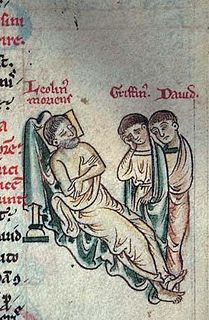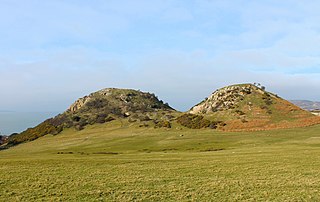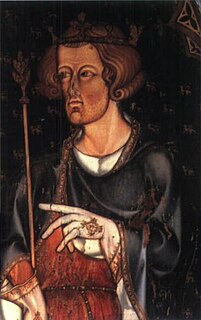
Llywelyn ap Gruffudd, sometimes written as Llywelyn ap Gruffydd, also known as Llywelyn the Last, was Prince of Wales from 1258 until his death at Cilmeri in 1282. The son of Gruffydd ap Llywelyn Fawr and grandson of Llywelyn the Great, he was the last sovereign prince of Wales before its conquest by Edward I of England.

Llywelyn the Great, full name Llywelyn mab Iorwerth), was a King of Gwynedd in north Wales and eventually ruler of all Wales. By a combination of war and diplomacy he dominated Wales for 45 years.

The Kingdom of Gwynedd was a Roman Empire successor state that emerged in sub-Roman Britain in the 5th century during the Anglo-Saxon settlement of Britain.

Llanrwst is a market town and community on the A470 road and the River Conwy, in Conwy County Borough, Wales, and the historic county of Denbighshire. It developed round the wool trade and became known also for the making of harps and clocks. Today, less than a mile from the edge of Snowdonia, its main pursuit is tourism. Notable buildings include almshouses, two 17th-century chapels, and the Parish Church of St Grwst, which holds a stone coffin of Llywelyn the Great. The 2011 census gave it a population of 3,323.

Conwy, previously known in English as Conway, is a walled market town and community in Conwy County Borough on the north coast of Wales. The town, which faces Deganwy across the River Conwy, formerly lay in Gwynedd and prior to that in Caernarfonshire. The community, which includes Deganwy and Llandudno Junction, had a population of 14,753 at the 2011 census. and is a popular tourist destination. The size of the resident population in Conwy County Borough on 30 June 2015 was estimated to be 116,200 people. The town itself has a population of 4,065.

The Principality of Wales existed between 1216 and 1536, encompassing two-thirds of modern Wales during its height between 1267 and 1277. For most of its history it was ’annexed and united’ to the English Crown except for its earliest few decades. However, for a few generations, specifically the period from its foundation in 1216 to the completion of the conquest of Wales by Edward I in 1284, it was de facto independent under a Welsh prince of Wales, albeit one who swore fealty to the king of England.
Owain ap Gruffudd was brother to Llywelyn ap Gruffudd and Dafydd ap Gruffudd and, for a brief period in the late 1240s and early 1250s, ruler of part of the Kingdom of Gwynedd.
Hywel ab Owain Gwynedd, Wales Prince of Gwynedd in 1170, was a Welsh poet and military leader. Hywel was the son of Owain Gwynedd, prince of Gwynedd, and an Irishwoman named Pyfog. In recognition of this, he was also known as Hywel ap Gwyddeles. Hywel was also known as the Poet Prince for his bardic skills.

Deganwy is a town and electoral ward in Conwy County Borough in Wales with a population of 3,936 (2011). It lies in the Creuddyn Peninsula alongside Llandudno and Rhos-on-Sea. Historically part of Caernarfonshire, the peninsula is in a region of north Wales where as many as 1 in 3 of residents are able to speak Welsh, and is home to some of the most expensive streets in Wales. Deganwy is located to the east of the town of Conwy and with it forms the Conwy community. The name Deganwy has been interpreted in modern times as Din-Gonwy, which would mean "Fort on the River Conwy", but the historical spellings make it impossible for this to be the actual origin of the name although mentioned in Domesday Book is "the territory of the Decanae tribe". The original wooden castle was rebuilt in stone after 1210. Deganwy is in the ecclesiastical parish of Llanrhos, and has a Victorian era Gothic parish church dedicated to All Saints.
Madog ap Llywelyn was the leader of the Welsh revolt of 1294–95 against English rule. The revolt was surpassed in longevity only by the revolt of Owain Glyndŵr in the 15th century. Madog belonged to a junior branch of the House of Aberffraw and was a distant relation of Llywelyn ap Gruffudd, the last recognised native Prince of Wales.
Ednyfed Fychan, full name Ednyfed Fychan ap Cynwrig, was a Welsh warrior who became seneschal to the Kingdom of Gwynedd in Northern Wales, serving Llywelyn the Great and his son Dafydd ap Llywelyn. Fychan claimed descent from Marchudd ap Cynan, Lord of Rhos, 'protector' of Rhodri Mawr, King of Gwynedd. He was ancestor of Owen Tudor and thereby of the Tudor dynasty.

Aberconwy Abbey was a Cistercian foundation at Conwy, later transferred to Maenan near Llanrwst, and in the 13th century was the most important abbey in the north of Wales.
Perfeddwlad or Y Berfeddwlad was an historic name for the territories in Wales lying between the River Conwy and the River Dee. comprising the cantrefi of Rhos, Rhufoniog, Dyffryn Clwyd and Tegeingl. Perfeddwlad thus was also known as the Four Cantrefs.

Iorwerth mab Owain Gwynedd, also called Edward, was the eldest legitimate son of Owain Gwynedd and his first wife Gwladys (Gladys) ferch Llywarch. He married Marared ferch Madog. His son, Llywelyn the Great, eventually united the realm and became known as Llywelyn Fawr and is one of Wales's most famous monarchs. Iorwerth received Nant Conwy as his inheritance from his father, Owain Gwynedd. However, he did not receive the crown succession, as was the normal tradition, because of his nose defect.

Deganwy Castle was an early stronghold of Gwynedd and lies in Deganwy at the mouth of the River Conwy in Conwy, north Wales. It lies at an elevation of 110 m (361 ft) on a volcanic plug.

The history of Gwynedd in the High Middle Ages is a period in the History of Wales spanning the 11th through the 13th centuries. Gwynedd, located in the north of Wales, eventually became the most dominant of Welsh kingdoms during this period. Distinctive achievements in Gwynedd include further development of Medieval Welsh literature, particularly poets known as the Beirdd y Tywysogion associated with the court of Gwynedd; the reformation of bardic schools; and the continued development of Cyfraith Hywel. All three of these further contributed to the development of a Welsh national identity in the face of Anglo-Norman encroachment of Wales.
Culture and Society in Gwynedd during the High Middle Ages refers to a period in the History of Wales spanning the 11th, 12th, and 13th centuries. The High Middle Ages were preceded by the Early Middle Ages and followed by the Late Middle Ages. Gwynedd is located in the north of Wales.

Dafydd ap Llywelyn was Prince of Gwynedd from 1240 to 1246. He was the first ruler to claim the title Prince of Wales.

The conquest of Wales by Edward I, sometimes referred to as the Edwardian Conquest of Wales, to distinguish it from the earlier Norman conquest of Wales, took place between 1277 and 1283. It resulted in the defeat and annexation of the Principality of Wales, and the other last remaining independent Welsh principalities, by Edward I, King of England.











